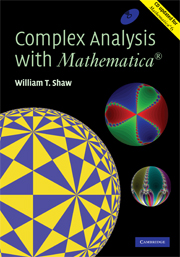Book contents
- Frontmatter
- Contents
- Preface
- 1 Why you need complex numbers
- 2 Complex algebra and geometry
- 3 Cubics, quartics and visualization of complex roots
- 4 Newton—Raphson iteration and complex fractals
- 5 A complex view of the real logistic map
- 6 The Mandelbrot set
- 7 Symmetric chaos in the complex plane
- 8 Complex functions
- 9 Sequences, series and power series
- 10 Complex differentiation
- 11 Paths and complex integration
- 12 Cauchy's theorem
- 13 Cauchy's integral formula and its remarkable consequences
- 14 Laurent series, zeroes, singularities and residues
- 15 Residue calculus: integration, summation and the argument principle
- 16 Conformal mapping I: simple mappings and Möbius transforms
- 17 Fourier transforms
- 18 Laplace transforms
- 19 Elementary applications to two-dimensional physics
- 20 Numerical transform techniques
- 21 Conformal mapping II: the Schwarz—Christoffel mapping
- 22 Tiling the Euclidean and hyperbolic planes
- 23 Physics in three and four dimensions I
- 24 Physics in three and four dimensions II
- Bibliograpy
- Index
4 - Newton—Raphson iteration and complex fractals
Published online by Cambridge University Press: 05 August 2014
- Frontmatter
- Contents
- Preface
- 1 Why you need complex numbers
- 2 Complex algebra and geometry
- 3 Cubics, quartics and visualization of complex roots
- 4 Newton—Raphson iteration and complex fractals
- 5 A complex view of the real logistic map
- 6 The Mandelbrot set
- 7 Symmetric chaos in the complex plane
- 8 Complex functions
- 9 Sequences, series and power series
- 10 Complex differentiation
- 11 Paths and complex integration
- 12 Cauchy's theorem
- 13 Cauchy's integral formula and its remarkable consequences
- 14 Laurent series, zeroes, singularities and residues
- 15 Residue calculus: integration, summation and the argument principle
- 16 Conformal mapping I: simple mappings and Möbius transforms
- 17 Fourier transforms
- 18 Laplace transforms
- 19 Elementary applications to two-dimensional physics
- 20 Numerical transform techniques
- 21 Conformal mapping II: the Schwarz—Christoffel mapping
- 22 Tiling the Euclidean and hyperbolic planes
- 23 Physics in three and four dimensions I
- 24 Physics in three and four dimensions II
- Bibliograpy
- Index
Summary
Introduction
You may already have seen how to solve polynomial equations numerically in Chapter 3, using the NSolve function, or FindRoot. How in general can we solve an equation, polynomial or otherwise, numerically? There are many schemes for doing this, with one or perhaps many variables. Given that we cannot solve most polynomials, or indeed other equations, in an exact analytical form, we need to consider a numerical treatment.
Let's look now at the most important such scheme. It leads naturally to the consideration of the solution of polynomial equations by iteration of rational functions, and this chapter is a brief introduction to this theory. Entire books can and have been written about both the art and mathematics of this. In the view of the author there is none better than that by Beardon (1991), which should be consulted by anyone serious about exploring the matter thoroughly. This chapter contains only introductory analytical comments on the matter, and for the most part we shall focus on exploring the art with Mathematica!
So here we take a novel route, looking at how the business of equation solving, which was the motivation for introducing complex numbers in the 16th century, becomes a whole new area of interest when we combine complex numbers with a computer system.
Note that in this chapter we shall be producing moderately complicated graphics. A machine running at 1 GHz or better is recommended for interactive use of the more complicated examples presented. If you are using an old machine just lower the plot resolution.
- Type
- Chapter
- Information
- Complex Analysis with MATHEMATICA® , pp. 56 - 77Publisher: Cambridge University PressPrint publication year: 2006



